Sometimes those new to the LEGO hobby and people with a smaller LEGO collection get a little discouraged when they see the impressive large displays and dioramas of other LEGO fans. This is one of the reasons I like to regularly feature examples of micro-building with LEGO. Micro-building doesn’t require having a lot of parts, but it is more about thoughtful placement and clever usage of the pieces you already have. LEGO themselves runs a series of tutorials for building on a small scale (see links at the end of this post), and the LEGO Architecture line is a good example of what can be achieved on a small scale with relatively few pieces. And, of course, there are many examples of micro-building from the LEGO fan community. 🙂

Recently, the BrothersBrick featured the work of LEGO fan Jeff Friesen (see: Time to Travel to Beautiful Cityscapes), who is not just a master of micro-building, but an expert at using shape and color. I was so impressed with Jeff’s creations, that I thought to share some of them with you here as well. The futuristic city on the first picture above was built on a 20×20 stud base, and was inspired by the new curved tile pieces. Jeff said he first saw the new tiles in the LEGO lettering contest by New Elementary (see: Lettering with LEGO Using New Tile Shapes), and he immediately imagined them as elevated highways in a micro-scale city. Once creating the loops of the highway, the city naturally grew around it.
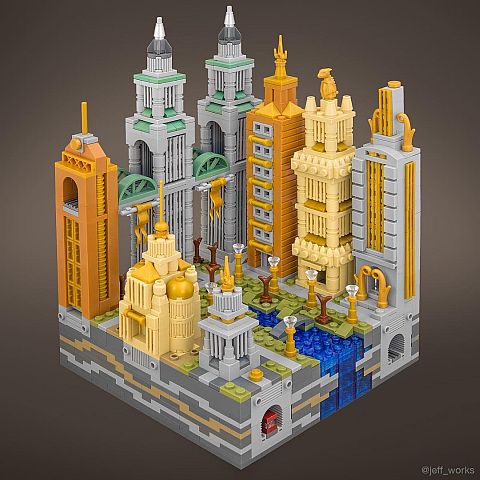
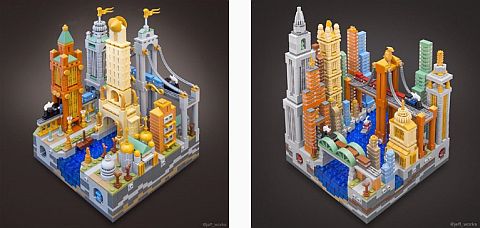
The next three vignettes are variations of similar cityscapes, with a mix of both classic and modern style architecture. They all feature a central canal with a suspension bridge, surrounded by high-rise buildings. Notice that many of the structures are simply stacked plates, but because of the careful choice of colors and some decorations, they really come alive. Also, don’t miss the tiny trains both on the overhead bridges and underground!
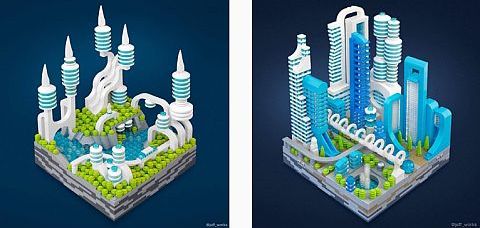
Jeff also built a couple of fully futuristic cities, using mostly white and turquoise rounded shapes, surrounded by some green pieces to represent landscaping. Jeff shares that he gathered in a pile all the curved pieces he had, and just started putting them together. Over time, the haphazard constructions evolved into what you see here. He says that “it was like chicken scratches slowly taking the form of a balanced drawing”. Just to show that even though the end result looks carefully planned, the design process is actually a mixture of experimentation, vision, and happy little accidents (as Bob Ross would say).
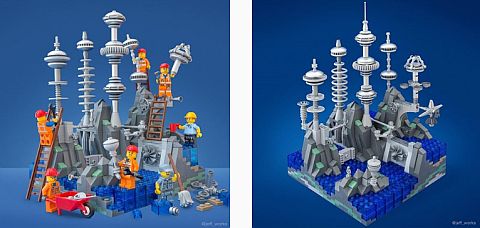
Continuing to progress into the future, the city above is from the distant future, with even more modern, almost alien shapes. Jeff took advantage of lots of little pieces and accessories with interesting designs; like binoculars, frying pans, gears, clips, wheels, propellers, lightsaber hilts, and jackhammers. The micro-city worked on by minifigs really puts the size into perspective; it looks big, but it is actually very tiny.
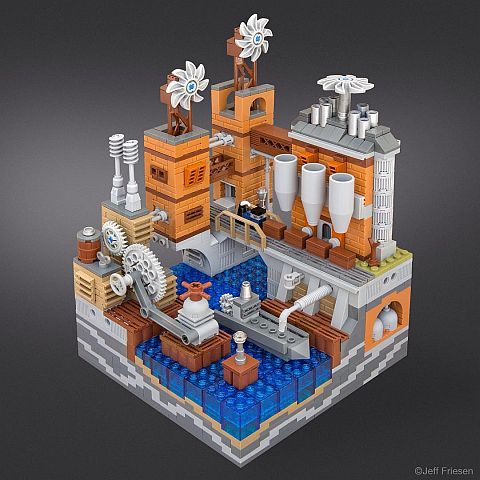
Going back to the past, Jeff pays homage to the Industrial Age. He shares: “If you can overlook the smog, hard labor, and environmental catastrophes of the Industrial Age, the era was a rich source of architectural wonders. Massive brick buildings loomed overhead like the great temples of antiquity. While industrial buildings are not decorative in nature, their maze-like complexity and sheer bulk does give a sense of awe.”
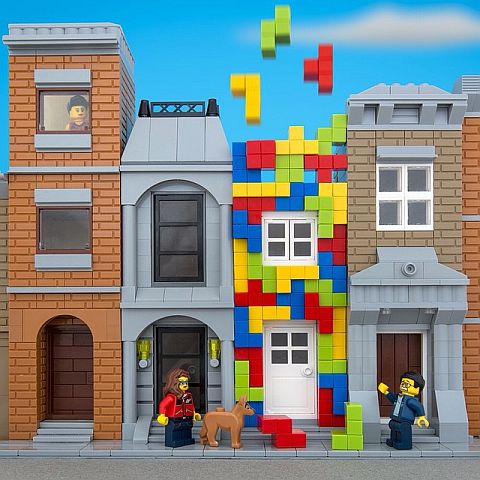
Jeff shares many other wonderful LEGO creations (both micro-scale and minifigure-scale) under his Instagram profile. As you will see, none of his work is very large or use a lot of pieces, but are more focused on thoughtful selection of parts and colors, careful posing, and excellent photography. So, whether you have lots of LEGO parts, or only a handful, you have an opportunity to build entire worlds. So, give it a try! And if you need something to start with to build your own tiny cities, you might consider checking out the LEGO Architecture collection, particularly the LEGO Architecture Skyline Series. You can find the sets at the LEGO Architecture section of the Online LEGO Shop.
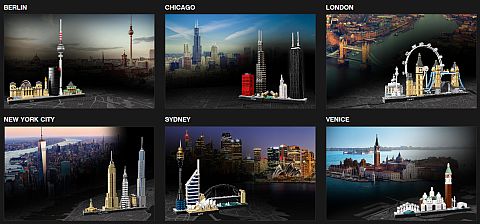
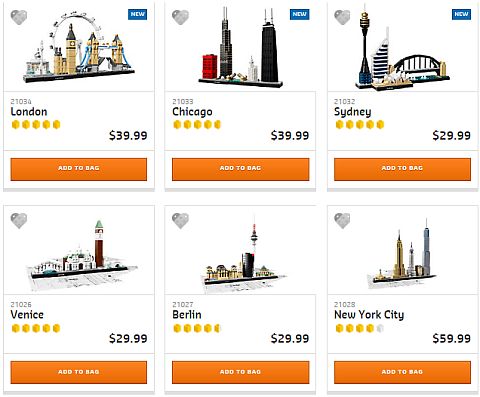
What do you think? How do you like these LEGO micro-scale cities? Which one is your favorite? Did you notice any interesting use of parts that you really like? Have you tried micro-building yourself? Or, do you prefer to build in minifigure-scale? Feel free to share your thoughts and own creations in the comment section below! 😉
And you might also like to check out the following related posts:












As I Discovered over the years of collecting, it matters to you and of what you think of your own creations . If you just doing it for the appreciation of your talents from other people ,then your not truly enjoying the hobby itself. However, it is fun to show the creative side of you. I envy those that can make large and detailed creations ,partly because I wish I can do the same. The smaller creations I can do. Like when I made a post office for my Lego city. It was simple and not a complicated build. I also noticed that some of the 2018 city sets are an easy re-creation. ( I can make it myself just as easily .)
Wow. These are really impressive. Very beautiful too.
There is so much to look at here. Amazing. I would love to see this in the Architecture series. Are these on Ideas yet?
I don’t think they are on LEGO Ideas, but I would sure like to see them there too! 🙂
I could look at these all day! So many interesting little details. Very nice colors and parts usage. I agree with brickmaster, I would love to see these as official sets.
I’m very inspired by these. Time to bring out all those small pieces and start building. Thanks for sharing them.
Oh , I agree . I want to take back my first part in my comment. It’s another great way to expand in the Lego universe. In a small kinda way LoL.
Fantastic and truly inspiring. I would definitely purchase a book with these instructions!
A whole book of these would be awesome! I would buy that book too. I’m going to contact Jeff and see if he is interested. No-Starch-Press is always looking for talented builders. 🙂
Amazing! What really makes these stand out are the shapes and how all the buildings and colors come together. I don’t know if I would do something like this, but it’s encouraging to hear that even for Jeff it took many tries.
Those are some lovely micros, but I will say they frankly use more of certain pieces than I have 😉 . Just being micro doesn’t mean it’s not parts intensive, though it’s true enough that certain micros wouldn’t need as many parts. These are very creative though!
When I look at those my first reaction is “those are amazing”, my second reaction is “Why do I bother microdesigning? I’ll never make something that amazing.”